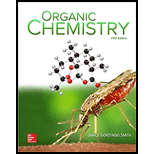
Concept explainers
Label each stereogenic center as
a.  c.
c.  e.
e.  g.
g.
b.  d.
d.  f.
f.  h.
h. 
(a)
Interpretation: The stereogenic center in the given compound is to be labeled as
Concept introduction: A carbon atom that has four nonequivalent atoms or groups attached to it is known as chiral carbon atom. Chiral carbon centers are also called as asymmetric or stereogenic centers.
The naming of chiral center and geometric isomers are based on Cahn-Ingold-Prelog priority rules. If the priority assigned to each group attached to the chirality center in a molecule is in a clockwise direction, then it is the R-stereoisomer, and if this is counter-clockwise, then it is the S-stereoisomer. R and S-stereoisomer are mirror images of each other.
Answer to Problem 5.47P
The stereogenic center has
Explanation of Solution
The
(1) Assign numbering to the groups which are bonded to the chiral carbon based on the molecular weight and electronegativity.
(2) If the sequence of the numbering follows clockwise direction, the chiral atom is assigned
(3) If the sequence of the numbering follows anticlockwise direction, the chiral atom is assigned
(4) If the rotation is clock-wise and the least priority group is above the plane, then the configuration is inverted to the obtained configuration from the above CIP rule which means
In the given compound, the increasing order of priority assigned to the groups attached to chiral center is,
Therefore, the groups in the given compound are numbered as shown below.
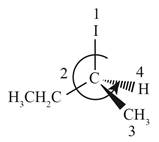
Figure 1
The rotation in the above compound is in anticlockwise direction. Hence, the stereogenic center has
(b)
Interpretation: The stereogenic center in the given compound is to be labeled as
Concept introduction: A carbon atom that has four nonequivalent atoms or groups attached to it is known as chiral carbon atom. Chiral carbon centers are also called as asymmetric or stereogenic centers.
The naming of chiral center and geometric isomers are based on Cahn-Ingold-Prelog priority rules. If the priority assigned to each group attached to the chirality center in a molecule is in a clockwise direction, then it is the R-stereoisomer, and if this is counter-clockwise, then it is the S-stereoisomer. R and S-stereoisomer are mirror images of each other.
Answer to Problem 5.47P
The stereogenic center has
Explanation of Solution
In the given compound, the increasing order of priority assigned to the groups attached to chiral center is,
Therefore, the groups in the given compound are numbered as shown below.
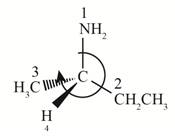
Figure 2
The rotation in the above compound is in clockwise direction and the least priority group is above the plane, then the configuration is inverted. Hence, the stereogenic center has
(c)
Interpretation: The stereogenic center in the given compound is to be labeled as
Concept introduction: A carbon atom that has four nonequivalent atoms or groups attached to it is known as chiral carbon atom. Chiral carbon centers are also called as asymmetric or stereogenic centers.
The naming of chiral center and geometric isomers are based on Cahn-Ingold-Prelog priority rules. If the priority assigned to each group attached to the chirality center in a molecule is in a clockwise direction, then it is the R-stereoisomer, and if this is counter-clockwise, then it is the S-stereoisomer. R and S-stereoisomer are mirror images of each other.
Answer to Problem 5.47P
The stereogenic center has
Explanation of Solution
In the given compound, the increasing order of priority assigned to the groups attached to chiral center is,
Therefore, the groups in the given compound are numbered as shown below.
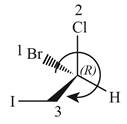
Figure 3
The rotation in the above compound is in clockwise direction. Hence, the stereogenic center has
(d)
Interpretation: The stereogenic center in the given compound is to be labeled as
Concept introduction: A carbon atom that has four nonequivalent atoms or groups attached to it is known as chiral carbon atom. Chiral carbon centers are also called as asymmetric or stereogenic centers.
The naming of chiral center and geometric isomers are based on Cahn-Ingold-Prelog priority rules. If the priority assigned to each group attached to the chirality center in a molecule is in a clockwise direction, then it is the R-stereoisomer, and if this is counter-clockwise, then it is the S-stereoisomer. R and S-stereoisomer are mirror images of each other.
Answer to Problem 5.47P
Both the stereogenic centers has
Explanation of Solution
In the given compound, two chiral centers are present.
Therefore, the groups in the given compound are numbered as shown below.

Figure 4
The rotation of first chiral center in the above compound is in clockwise direction and second chiral center shows anticlockwise rotation. In second chiral center, the least priority group is above the plane, and then the configuration is inverted. Hence, both the stereogenic centers has
(e)
Interpretation: The stereogenic center in the given compound is to be labeled as
Concept introduction: A carbon atom that has four nonequivalent atoms or groups attached to it is known as chiral carbon atom. Chiral carbon centers are also called as asymmetric or stereogenic centers.
The naming of chiral center and geometric isomers are based on Cahn-Ingold-Prelog priority rules. If the priority assigned to each group attached to the chirality center in a molecule is in a clockwise direction, then it is the R-stereoisomer, and if this is counter-clockwise, then it is the S-stereoisomer. R and S-stereoisomer are mirror images of each other.
Answer to Problem 5.47P
The stereogenic center has
Explanation of Solution
The groups in the given compound are numbered as shown below.
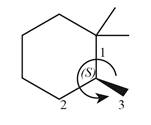
Figure 5
The rotation in the above compound is in anticlockwise direction and the least priority group is below the plane. Hence, the stereogenic center has
(f)
Interpretation: The stereogenic center in the given compound is to be labeled as
Concept introduction: A carbon atom that has four nonequivalent atoms or groups attached to it is known as chiral carbon atom. Chiral carbon centers are also called as asymmetric or stereogenic centers.
The naming of chiral center and geometric isomers are based on Cahn-Ingold-Prelog priority rules. If the priority assigned to each group attached to the chirality center in a molecule is in a clockwise direction, then it is the R-stereoisomer, and if this is counter-clockwise, then it is the S-stereoisomer. R and S-stereoisomer are mirror images of each other.
Answer to Problem 5.47P
Both the stereogenic centers has
Explanation of Solution
In the given compound, two chiral centers are present.
Therefore, the groups in the given compound are numbered as shown below.
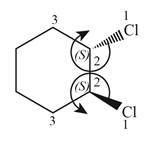
Figure 6
The rotation of first chiral center in the above compound is in clockwise direction and second chiral center shows anticlockwise rotation. In first chiral center, the highest priority group is below the plane, and then the configuration is inverted to
(g)
Interpretation: The stereogenic center in the given compound is to be labeled as
Concept introduction: A carbon atom that has four nonequivalent atoms or groups attached to it is known as chiral carbon atom. Chiral carbon centers are also called as asymmetric or stereogenic centers.
The naming of chiral center and geometric isomers are based on Cahn-Ingold-Prelog priority rules. If the priority assigned to each group attached to the chirality center in a molecule is in a clockwise direction, then it is the R-stereoisomer, and if this is counter-clockwise, then it is the S-stereoisomer. R and S-stereoisomer are mirror images of each other.
Answer to Problem 5.47P
Both the stereogenic centers has
Explanation of Solution
In the given compound, two chiral centers are present.
Therefore, the groups in the given compound are numbered as shown below.
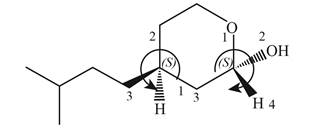
Figure 7
The rotation of first chiral center in the above compound is in clockwise direction and second chiral center shows anticlockwise rotation. In first chiral center, the highest priority group is below the plane, and then the configuration is inverted to
(h)
Interpretation: The stereogenic center in the given compound is to be labeled as
Concept introduction: A carbon atom that has four nonequivalent atoms or groups attached to it is known as chiral carbon atom. Chiral carbon centers are also called as asymmetric or stereogenic centers.
The naming of chiral center and geometric isomers are based on Cahn-Ingold-Prelog priority rules. If the priority assigned to each group attached to the chirality center in a molecule is in a clockwise direction, then it is the R-stereoisomer, and if this is counter-clockwise, then it is the S-stereoisomer. R and S-stereoisomer are mirror images of each other.
Answer to Problem 5.47P
The configurations of three stereogenic centers are
Explanation of Solution
In the given compound, three chiral centers are present.
Therefore, the groups in the given compound are numbered as shown below.
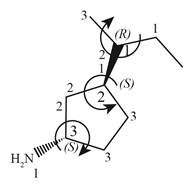
Figure 8
The rotation of first chiral center in the above compound is in clockwise direction. Thus, it has
(a) The stereogenic center has
(b) The stereogenic center has
(c) The stereogenic center has
(d) Both the stereogenic centers has
(e) Both the stereogenic centers has
(f) Both the stereogenic centers has
(g) Both the stereogenic centers has
(h) The configurations of three stereogenic centers are
Want to see more full solutions like this?
Chapter 5 Solutions
PKG ORGANIC CHEMISTRY
Additional Science Textbook Solutions
Biology: Life on Earth with Physiology (11th Edition)
Organic Chemistry
Applications and Investigations in Earth Science (9th Edition)
Anatomy & Physiology (6th Edition)
Principles of Anatomy and Physiology
- Which of the following orbitals intersect or overlap the x-axis in the standard cartesian coordinate system used? (Select ALL correct answers.) Group of answer choices px dxz dx2-y2 py dxy sarrow_forwardWhich of the following sets of elements is not a Dobereiner triad? (Choose the best answer.) Group of answer choices Li-Na-K Al-Ga-In Cr-Mo-W K-Rb-Csarrow_forwardDon't used Ai solution and don't used hand raitingarrow_forward
- Don't used hand raiting and don't used Ai solutionarrow_forwardGive the structure(s) of the product(s) the reaction below, and be sure to indicate any relative stereochemistry (you can assume that each of the Diels-Alder reactions will proceed with endo selectivity). Draw out relevant enantiomer(s) if they are expected to form. If no reaction is expected to occur under the indicated conditions, then write "no reaction" or NR, and explain why you would expect nothing to occur. If more than one product is formed, please indicate which one will be the major product or if they will be formed in equal amounts. In all cases, equimolar amounts of both components/reagents are present unless indicated otherwise I'm struggling to see how this reaction will go! I am wondering if it will cycle on itself but I'm not sure how I drew out a decagon but I'm a bit lostarrow_forwardGive the structure(s) of the product(s) for the reactions below, and be sure to indicate any relative stereochemistry (you can assume that each of the Diels-Alder reactions will proceed with endo selectivity). Draw out relevant enantiomer(s) if they are expected to form. If no reaction is expected to occur under the indicated conditions, then write "no reaction" or NR, and explain why you would expect nothing to occur. If more than one product is formed, please indicate which one will be the major product or if they will be formed in equal amounts. In all cases, equimolar amounts of both components/reagents are present unless indicated otherwise .arrow_forward
- Calculate the residence time of strontium (Sr2+) in the world ocean, given that the average concentration of strontium in the world’s rivers is approximately 0.87 µmol L-1 (5 pts).arrow_forwardA package contains 1.33lbs of ground round. If it contains 29% fat, how many grams of fat are in the ground? arrow_forwardHow is the resonance structure formed to make the following reaction product. Please hand draw the arrows showing how the electrons move to the correct position. Do not use an AI answer. Please draw it yourself or don't bother.arrow_forward
- Part II Calculate λ max of the following compounds using wood ward- Fiecer rules a) b) c) d) e) OH OH dissolved in dioxane Br Br dissolved in methanol. NH₂ OCH 3 OHarrow_forward6. Match each of the lettered items in the column on the left with the most appropriate numbered item(s) in the column on the right. Some of the numbered items may be used more than once and some not at all. a. Z = 37 1. b. Mn 2. C. Pr element in period 5 and group 14 element in period 5 and group 15 d. S e. [Rn] 7s¹ f. d block metal 3. highest metallic character of all the elements 4. paramagnetic with 5 unpaired electrons 5. 4f36s2 6. isoelectronic with Ca²+ cation 7. an alkaline metal 8. an f-block elementarrow_forwardDraw all formal charges on the structures below as is and draw 1 resonance structure that is more stable.arrow_forward
 ChemistryChemistryISBN:9781305957404Author:Steven S. Zumdahl, Susan A. Zumdahl, Donald J. DeCostePublisher:Cengage Learning
ChemistryChemistryISBN:9781305957404Author:Steven S. Zumdahl, Susan A. Zumdahl, Donald J. DeCostePublisher:Cengage Learning ChemistryChemistryISBN:9781259911156Author:Raymond Chang Dr., Jason Overby ProfessorPublisher:McGraw-Hill Education
ChemistryChemistryISBN:9781259911156Author:Raymond Chang Dr., Jason Overby ProfessorPublisher:McGraw-Hill Education Principles of Instrumental AnalysisChemistryISBN:9781305577213Author:Douglas A. Skoog, F. James Holler, Stanley R. CrouchPublisher:Cengage Learning
Principles of Instrumental AnalysisChemistryISBN:9781305577213Author:Douglas A. Skoog, F. James Holler, Stanley R. CrouchPublisher:Cengage Learning Organic ChemistryChemistryISBN:9780078021558Author:Janice Gorzynski Smith Dr.Publisher:McGraw-Hill Education
Organic ChemistryChemistryISBN:9780078021558Author:Janice Gorzynski Smith Dr.Publisher:McGraw-Hill Education Chemistry: Principles and ReactionsChemistryISBN:9781305079373Author:William L. Masterton, Cecile N. HurleyPublisher:Cengage Learning
Chemistry: Principles and ReactionsChemistryISBN:9781305079373Author:William L. Masterton, Cecile N. HurleyPublisher:Cengage Learning Elementary Principles of Chemical Processes, Bind...ChemistryISBN:9781118431221Author:Richard M. Felder, Ronald W. Rousseau, Lisa G. BullardPublisher:WILEY
Elementary Principles of Chemical Processes, Bind...ChemistryISBN:9781118431221Author:Richard M. Felder, Ronald W. Rousseau, Lisa G. BullardPublisher:WILEY





